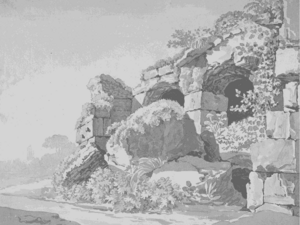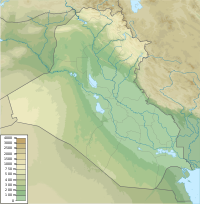دلبات
 | |
| المكان | Iraq |
|---|---|
| الإحداثيات | 32°17′44″N 44°27′58″E / 32.29556°N 44.46611°E |
| النوع | settlement |
| ملاحظات حول الموقع | |
| تواريخ الحفريات | 1890s, 1989 |
| الأثريون | هرمز رسام، J. A. Armstrong |
| الحالة | أطلال |
| الملكية | Public |
| الاتاحة للعامة | Yes |
دلبات Dilbat (تسمى حاليا بتل الدليم) , هي مدينة سومرية قديمة تقع جنوب بابل على الضفة الشرقية لنهر الفرات في محافظة القادسية في العراق. It lies 15 kilometers south of the ancient city of Borsippa. وكانت مدينة دلبات تحتوي على زقورة إي-إيبى-آنو، مخصصة لعبادة الإلهة أوراش Urash، وكانت تقع في وسط المدينة وهي مذكورة في ملحمة جلجامش.[1]
تاريخ المدينة
تم تأسيس مدينة دلبات خلال السلالة السومرية الثانية قبل حوالي 2700 سنة قبل الميلاد وكانت خاضعة لمر العصور على سيطرة الأكديين و البابليون و الكاشيين و الساسانيين وبعدها للالعرب المسلمين وكانت زراعة القمح منتشرة بها وكانت تمر بها قناة اراهتو .
الحفريات
كشفت االحفريات في تل الدليم عن وجود مدينة سومرية قديمة في ذلك الموقع وكان عالم الاثار العراقي هرمز رسام قد كشف بعض الألواح الطينية كانت تعود إلى حوالي سنة 2700 ق.م.
The site of Tell al-Deylam consists of two mounds, a small western mound with 1st millennium BC and Early Islamic remains and a larger east mound, roughly 500 meters in circumference, with remains from the 1st to 3rd millennium BC. Dilbat was excavated briefly by Hormuzd Rassam, who recovered some cuneiform tablets at the site, mainly from the Neo-Babylonian period.[2] The site was worked in 1989 by J. A. Armstrong of the Oriental Institute of Chicago.[3][4][5] Though Dilbat itself has only been lightly excavated by archaeologists, numerous tablets from there have made their way to the antiquities market over the years as the result of unauthorized digging.
Excavations, by the Department of Archaeology of the University of Babylon, have resumed. Work began in 2017 and extended at least until 2020. A Kassite period temple to the city god was uncovered. Inscriptions were of one of the kings named Kurigalzu.[6][7]
الإله الوصي
Dilbat, like many other Mesopotamian settlements had its own tutelary deity, Urash, a male deity distinct from the more well known goddess Urash associated with Anu.[8] He was regarded as a farming god and a warror,[9] similar to Ninurta.
Urash was regarded as the father of Nanaya, a goddess of love from the entourage of Inanna,[10] as well as the minor underworld deity Lagamal,[11] worshiped in Susa as an attendant of Inshushinak moreso than in Mesopotamia.[12] Urash was also the husband of Ninegal ("lady of the palace"), and they had a joint temple,[13] as attested by an Assyrian account of its renovation undertaken on the orders of Ashur-etil-ilani.[14]
انظر أيضاً
الهامش
- ^ [1] Stephen Langdon, The Epic of Gilgamish. ثمة شظية من أسطورة جلجامش مكتوبة بالمسمارية البابلية القديمة، 1919.
- ^ Hormuzd Rassam and Robert William Rogers, Asshur and the land of Nimrod, Curts & Jennings, 1897
- ^ [2]Armstrong, J.A., "Surface Survey at Tell al-Deylam", Sumer 47, pp. 28-29, 1995
- ^ J. A. Armstrong, Dilbat revisited: the Tell al-Deylam project, Mar Sipri, vol. 3, no. 1, pp, 1-4, 1990
- ^ James A. Armstrong, West of Edin: Tell al-Deylam and the Babylonian City of Dilbat, The Biblical Archaeologist, vol. 55, no. 4, pp. 219-226, 1992
- ^ Haider Oraibi Almamori and Alexa Bartelmus, "New Light on Dilbat: Kassite Building Activities on the Uraš Temple “E-Ibbi-Anum” at Tell al-Deylam", Zeitschrift für Assyriologie und vorderasiatische Archäologie, vol. 111, iss. 2, 2021
- ^ Omran, M., H. A. Oraibi [Almamori]/K. J. Salman (2019): natā’iǧ tanqībāt Tall ad-Daylam (Dilbāt). al-mausim al-avval 2017 [= Results of the excavations at Tell at-Deylam (Dilbat). First season 2017], Sumer 65, 3–34 (Arabic section)
- ^ M. Krebernik, Uraš A [in:] Reallexikon der Assyriologie und vorderasiatischen Archäologie vol. 14, 2014, p. 404; note that in the electronic edition authors of the entry on the two deities named Uraš and geographical location in Asia Minor are accidentally swapped
- ^ Ch. Lilyquist, The Dilbat Hoard, Metropolitan Museum Journal 29, 1994, p. 6; note there's a typo in the article, "Ningal" is mentioned instead of "Ninegal"
- ^ O. Drewnowska-Rymarz, Mesopotamian Goddess Nanajā, 2008, p. 139
- ^ K. van der Torn, Migration and the Spread of Local Cults [in:] A. Schoors, K. Van Lerberghe (eds.), Immigration and Emigration Within the Ancient Near East: Festschrift E. Lipinski, 1995, p. 368
- ^ W. G. Lambert, Lāgamāl [in] Reallexikon der Assyriologie und vorderasiatischen Archäologie vol 6, 1983, p. 418-419
- ^ G. De Clercq, Die Göttin Ninegal/Bēlet-ekallim nach den altorientalischen Quellen des 3. und 2. Jt. v. Chr. mit einer Zusammenfassung der hethitischen Belegstellen sowie der des 1.Jt. v. Chr. (dissertation), 2004, p. 17, footnote 80: "Ninegal und Uraš, der Stadtgott von Dilbat, formen hier ein Paar. Siehe Unger, RlA 2 ("Dilbat") 222 über den Tempel der Ninegal in Dilbat und ihre Verehrung als Gemahlin des Uraš. Über die doppelte Gestalt der Gottheit Uraš schreibt auch Kienast, in: Fs van Dijk (1985) 112f.: Er ist als männlicher Gott bekannt, als Stadtgott von Dilbat und allgemein in Nordbabylonien; andererseits kann die Gottheit weiblich sein ("die Erde") und mit An verbunden werden."
- ^ S. W. Holloway, Aššur is King! Aššur is King!: Religion in the Exercise of Power in the Neo-Assyrian Empire, 2002, p. 254
للاستزادة
- [3] Christine Lilyquist, The Dilbat Hoard, Metropolitan Museum Journal, vol. 29, pp. 5–36, 1994
- S. G. Koshurnikov and N. Yoffee, Old Babylonian Tablets from Dilbat in the Ashmolean Museum, Iraq, vol. 48, pp. 117–130, 1986
- Matthew W. Stolper, Late Achaemenid Texts from Dilbat, Iraq, vol. 54, pp. 119–139, 1992
- Joseph Etienne Gautier, Archives d'une famille de Dilbat au temps de la premiere dynastie de Babylone, Le Caire, 1908
- SG Koshurnikov,A Family Archive from Old Babylonian Dilbat, Vestnik Drevnii Istorii, vol. 168, pp. 123ff, 1984

